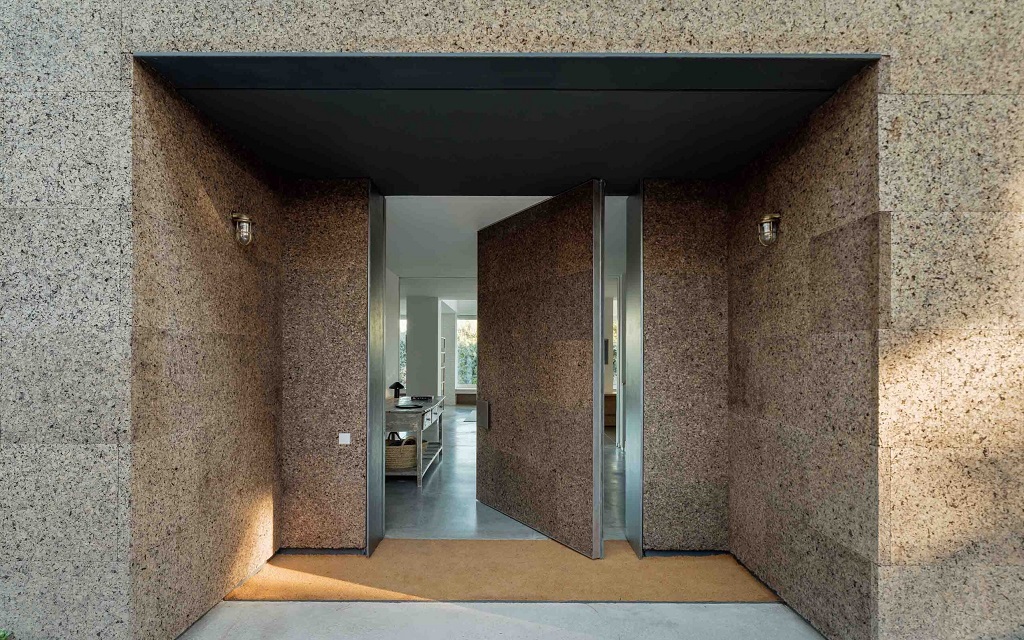The main image features the entrance to The Three Little Pigs Cork House in Madrid, Spain designed by EME157. Photo by Luis Díaz Díaz.
Cork, a versatile and eco-friendly material, continues to gain popularity in sustainable architecture. With its excellent insulation, durability, and aesthetics, cork is a preferred choice for a wide-range of energy-efficient construction and home improvement projects.
Once known simply for bottle stoppers and bulletin boards, cork has made a comeback due to manufacturing advancements and sustainability awareness.
In this article we explore cork’s increasing usage in construction, from insulation to interior design and structural elements.
When learning of cork’s many uniquely impressive traits, you will not be surprised as to why this invaluable natural resource is playing an increasingly important role in the future of construction and design.
Table of Contents
- Benefits of Using Cork in Construction Projects
- Types of Cork Used in Construction Projects
- Applications of Cork in Residential Properties
- Cork’s Unique Traits that Make It Ideal for Homes
- Cork: Playing a Key Role in Sustainable Building
- Cork Resources
Also see:
- Sustainable Uses & Benefits of Coconut Coir for Furniture & Home Décor
- Millboard: Sustainable Technology for Superior Decking & Outdoor Living
- 7 New Innovations in New Home Building
- More Related Construction & Sustainability Articles
- Related Topics: Sustainability | Construction | Renovations | Energy-Efficiency
Benefits of Using Cork in Construction Projects
Cork is a versatile material that offers numerous benefits when used in construction and architectural applications. Here are some of the reasons why cork is becoming more and more common as a building material.
Insulation Properties
Cork’s natural cellular structure makes it an exceptional insulator. Its closed-cell composition traps air within its structure, preventing heat transfer between spaces. This means using cork as insulation can help maintain comfortable indoor temperatures while reducing energy consumption for heating or cooling purposes. For homeowners looking to improve their home’s energy efficiency or lower utility bills, incorporating cork into their construction or renovation plans may be a wise decision.
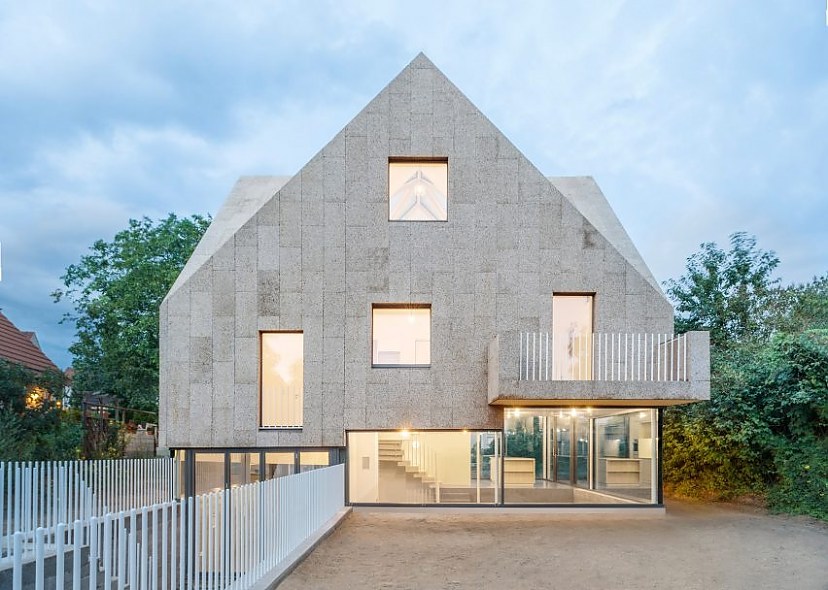
Cork Screw House, Berlin, Germany, featuring expanded insulation cork (Amorim MDFACADE).
Image courtesy of Amorim
Soundproofing Capabilities
In addition to thermal insulation properties, cork also excels at sound absorption. The same cellular structure responsible for its insulating abilities allows it to dampen noise effectively by absorbing vibrations from sounds before they reach adjacent rooms or spaces. As such, using cork materials for flooring or wall panels can significantly reduce noise transmission between rooms – perfect for those who value quiet homes!
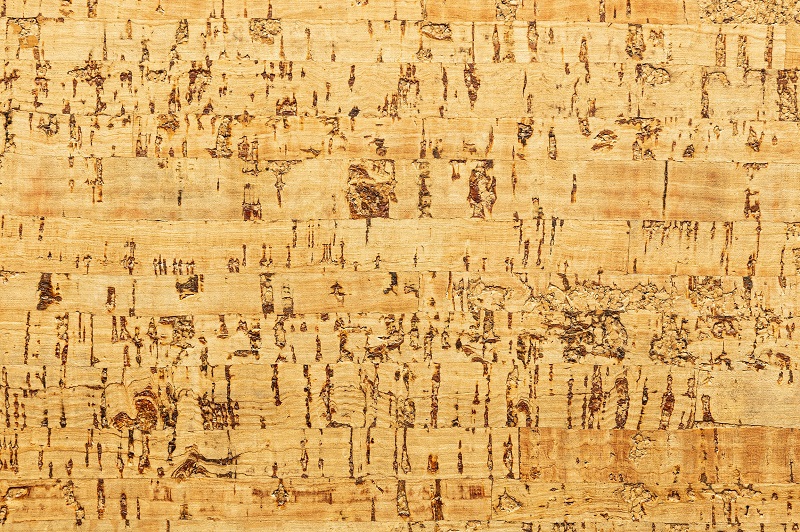
Closeup view of cork insulation that can be used for floors and walls
Also see:
Eco-Friendliness
One of the primary reasons behind the growing popularity of cork as a building material is its sustainability factor. Unlike other materials that require deforestation or mining processes during production, cork is the bark of the cork oak tree, which can be harvested without harming the tree itself.
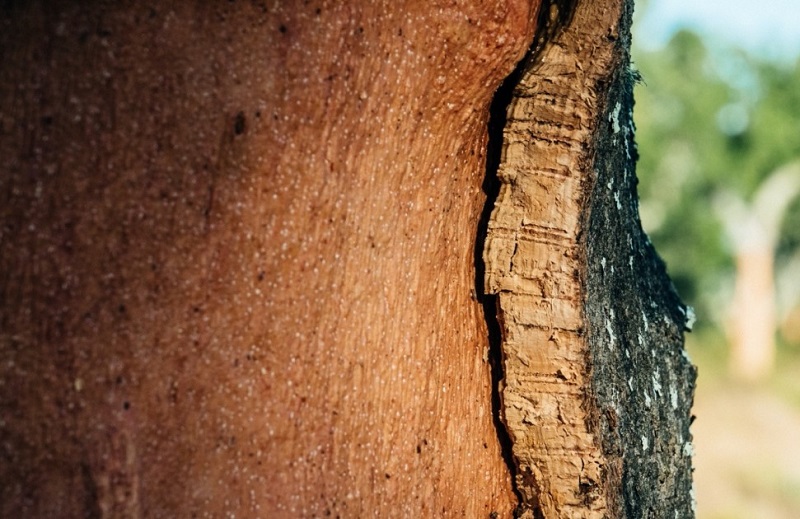
Closeup view of a stripped cork oak tree.
Image courtesy of Amorim
This process can be repeated every 9 to 12 years, making it a renewable resource. Cork can also be easily recycled or left to decompose naturally in landfills at the end of its life cycle. This makes it an environmentally-friendly option for those looking to reduce their reliance on inefficient resources when building or renovating homes.
Cork Harvesting Video from Amorim Cork Composites
Fire Resistance
Cork’s natural composition also provides excellent fire resistance. It contains a substance called suberin that acts as a natural flame retardant – meaning that cork does not readily ignite and will self-extinguish if exposed to flames. As such, incorporating cork into construction projects may help improve overall safety by reducing potential fire hazards within your home.
Types of Cork Used in Construction Projects
Being a versatile and eco-friendly material, cork has gained popularity in the building industry for its numerous benefits. There are several types of cork available, each with unique properties suited to different applications within home building and renovation projects.
Natural Cork Board
Natural cork board consists of large sheets made from compressed layers of raw bark harvested from the cork oak tree. This type of cork is known for its unique appearance, which features a distinct pattern of irregular shapes and textures that vary depending on the source tree’s age and growth conditions. Natural corkboard can be used in various applications within design projects, such as wall coverings or decorative panels that add visual interest, while also providing insulation benefits.
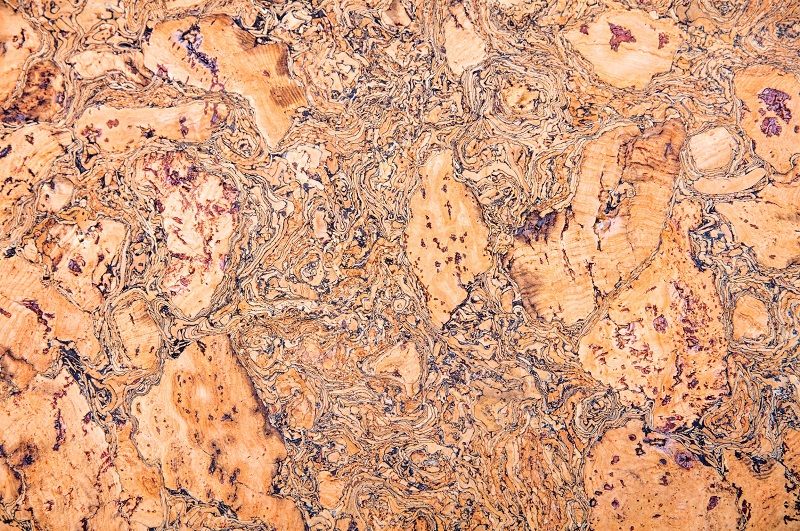
Closeup view of natural cork
Agglomerated Cork
Agglomerated cork is made by compressing small granules of natural cork using a binding agent, typically polyurethane or other synthetic resins. This type of cork is commonly used for insulation due to its excellent thermal resistance and sound absorption capabilities.
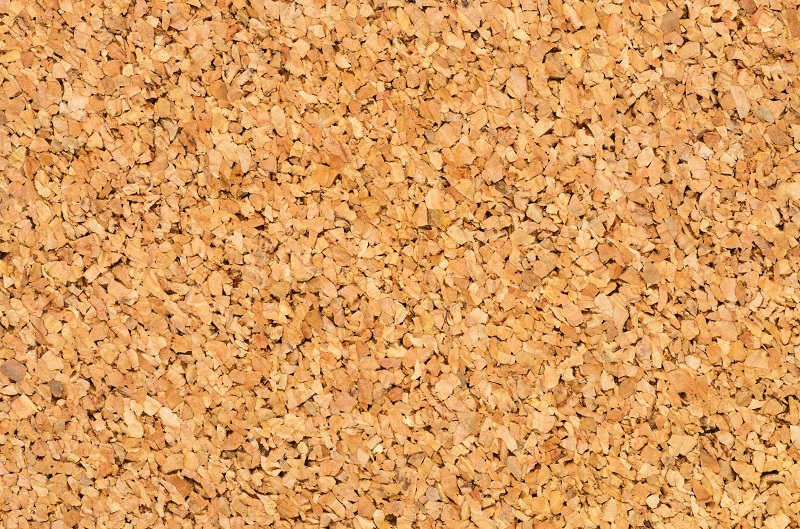
Closeup view of a sheet of agglomerated cork
Additionally, agglomerated cork can be easily shaped into various forms, such as sheets or rolls, making it suitable for underlayment beneath flooring materials like hardwood or laminate. Wine corks are another popular application for agglomerated cork.
Expanded Cork
Expanded cork, also known as black cork, is formed by heating natural granules at high temperatures until they expand and bind together without adhesive. The result is an extremely lightweight yet durable material with outstanding insulating properties.
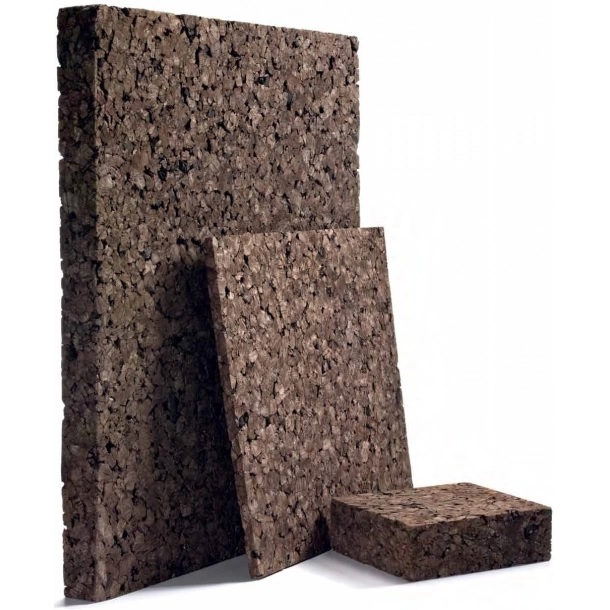
Due to its low density and minimal environmental impact during production, expanded cork has become increasingly popular as an alternative to traditional insulation materials such as fiberglass or mineral wool.
Cork Composite Materials
Another option for incorporating cork into your home is cork composite materials. These innovative products combine natural cork with other materials like rubber or foam to create hybrid solutions tailored to specific needs within construction and home improvement projects.
For example, some composites are designed specifically for use as acoustic barriers or thermal insulators. Others may offer increased durability and resistance to wear compared to traditional flooring options.
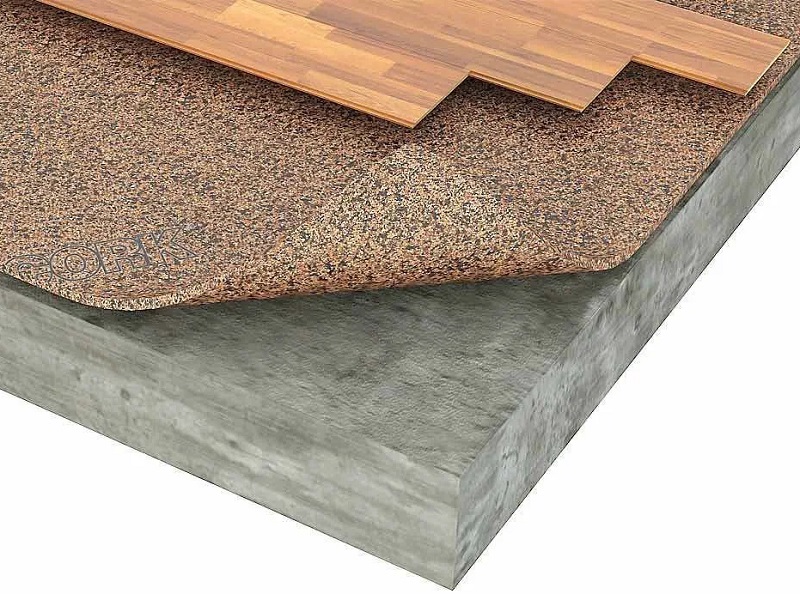
Sectional view of Amorim Cork Composites T66 Acousticork Cork & Rubber Composite Underlayment between hardwood planks and concrete subfloor
Applications of Cork in Residential Properties
As a versatile material, cork can be used for various applications in the residential construction industry, making it an attractive option for homebuyers and sellers alike. Here are some common uses of cork in residential properties:
Flooring
Cork flooring has become increasingly popular due to its durability, comfort underfoot, and insulation properties. It’s an excellent choice for areas with high foot traffic or where soundproofing is essential. Additionally, cork floors are resistant to mold and mildew growth, making them suitable for those with allergies.
Cork Flooring Brands
Wall Insulation
Cork can also be used as wall insulation, providing both thermal and acoustic benefits. Its cellular structure contains air pockets that help trap heat during winter while keeping homes cool during summer. By utilizing cork insulation, homeowners can not only reduce their energy costs but also enjoy the added benefit of increased water resistance.
Cork Insulation Brands
Rooftop Insulation
In addition to wall insulation, cork can also be utilized as rooftop insulation, offering similar thermal advantages, as well as added water resistance capabilities when properly installed with appropriate membranes.
Acoustic Insulation
Cork’s natural sound-absorbing properties make it an excellent material for acoustic insulation, particularly in spaces where noise reduction is crucial, such as home theaters or music studios. It can be installed in walls, ceilings, and floors to dampen sounds and vibrations effectively, while also providing additional thermal insulation benefits.
Furniture, Decorative Elements & Household Products
Beyond its functional applications in construction, cork can also be used creatively as furniture pieces or decorative elements within homes. Its unique texture adds visual interest while maintaining durability and eco-friendliness. Examples include custom-made cork tables, cork rugs and wall panels that can double as pin boards for added functionality.
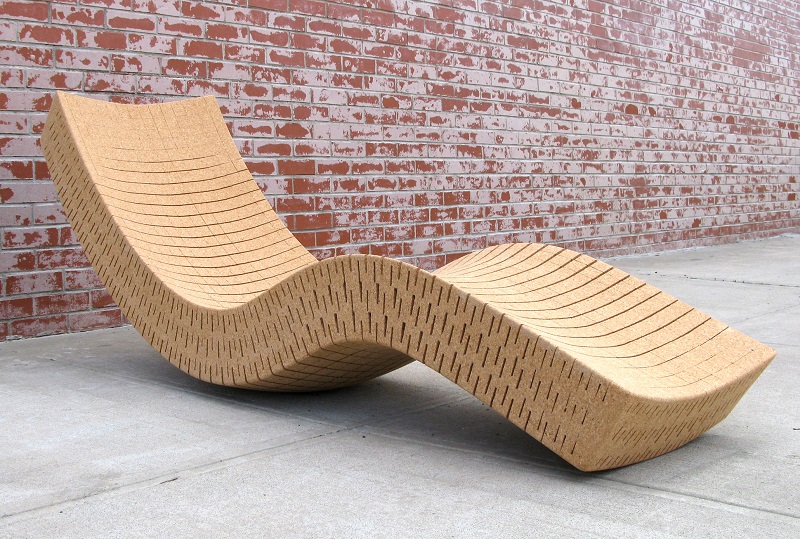
Cortiça chaise longue made with 100% recycled cork.
Image courtesy of Daniel Michalik
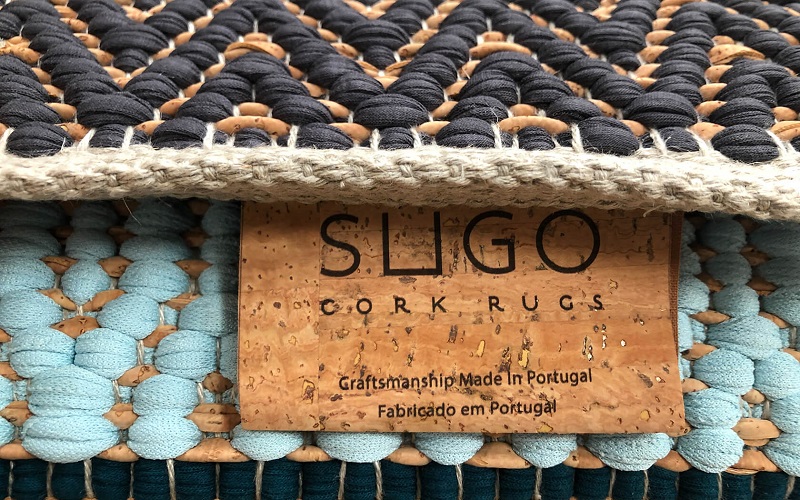
Closeup view of a Sugo cork rug
Cork’s Unique Traits that Make It Ideal for Homes
Cork’s unique traits gives it several advantages over other construction materials, making it an ideal choice for homebuyers and sellers:
- Lightweight Yet Strong and Durable
- Naturally Eco-Friendly
- Cost-Effective
- Aesthetically Appealing
- Flexible
Lightweight Yet Strong and Durable
One of the primary advantages of using cork in construction is its lightweight yet strong nature. Despite being significantly lighter than many traditional building materials like concrete or brick, cork still maintains impressive strength and durability. This makes it suitable for various applications such as flooring, insulation panels, or even structural elements. Cork’s resiliency permits it to retain its form and performance even under continuous usage.
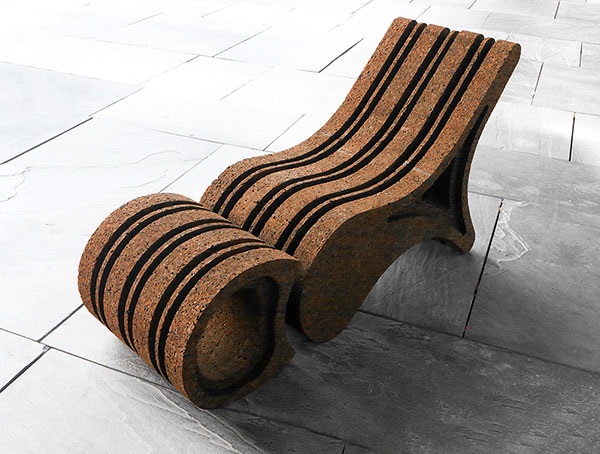
Image courtesy of experimentadesign
Naturally Eco-Friendly
In today’s world, where sustainability plays a crucial role in decision-making processes, cork stands out as an environmentally-friendly option for construction projects. Harvesting cork from trees does not harm them – instead, this process allows them to continue growing after their bark has been carefully removed every 9 to 12 years. Moreover, cork production generates minimal waste, with nearly all parts utilized during manufacturing processes.
Cost-Effective
While cork may have a slightly higher initial cost compared to some traditional materials, it offers long-term savings due to its durability and low maintenance requirements. Its natural resistance to moisture, mold, and pests means that homeowners can expect minimal repair or replacement costs over time. Additionally, the energy-saving benefits of cork insulation can reduce utility bills for heating and cooling systems.
Aesthetically Appealing
Cork’s unique appearance adds an attractive visual element when used as flooring or wall coverings in homes. Available in various colors and patterns, this material can be easily customized according to individual preferences while providing excellent functionality.
Cork is also appreciated for how it feels. Cork flooring is comfortable underfoot, making it ideal for areas with high foot traffic, such as living rooms and kitchens. When compared to other types of wood material, cork is often preferred for its “soft touch” and “warm feeling” it emits, as cork’s normal temperature is close to that of the human body.
Flexible
A key trait that continues to fuel product inventions using cork is its flexibility. Even at very low temperatures, cork is flexible to work with, as a result of the constituents (Suberin) and the geometry of its cell walls.
Cork Chaged Me – Daniel Michalik
Cork: Playing a Key Role in Sustainable Building
Cork has become a transformative material in building construction due to its many remarkable features. Its thermal and acoustic insulation, durability, and aesthetics make it a top choice for sustainable architectural practices.
By incorporating cork in flooring, insulation, walls, structures, décor, and more, it’s possible to achieve energy-efficiency for spaces that are also comfortable and aesthetically interesting.
Exploring the potential of cork will also put you in the middle of innovation within the construction industry and beyond.
Cork Resources
Cork Flooring Brands
Cork Insulation Brands
Examples of Innovative Applications of Cork
- AirFibr (hybrid natural grass with cork elements)
- Amorim Cork Ventures
- Asportuguesas (cork footwear)
- CorkSorb (sustainable absorbents)
- Grõwancork (cork insulation for refrigeration products)
- Infills for Artificial Turf
- Shockpads for Artificial Turf
- Sugo Cork Rugs
- YogurtNest
- Yoloha (cork yoga mats)
Cork Manufacturers, Suppliers & Resellers
- Amorim
- Amorim Cork Composites
- CorkHouse
- Corklink
- Corkstore24
- HZCORK (cork fabric)
- Manton
- Puretree
Related Construction & Sustainability Articles
- Best Roof Types to Prevent Storm Damage
- Building Technologies for Disaster Resistant Homes
- Want a Tough House that Looks Great? Try Engineered Wood Siding!
- 7 Tips on How to Make Your Home Up-to-Date & On-Trend
- Luxury Vinyl Plank Flooring: Friend or Faux?
- 5 Examples of Older Homes Returning Maximum Profit with Renovations
- Need Renovation Inspiration? Try These Innovative Design Resources!
| Purgula is reader-supported. When you click on links to other sites from our website, we may earn affiliate commissions, at no cost to you. If you find our content to be helpful, this is an easy way for you to support our mission. Thanks! Learn more. |

